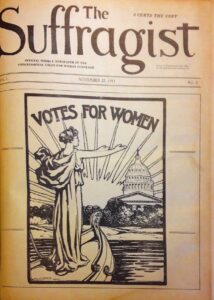Ann didn’t write this. Laura Wood at THE THINKING HOUSEWIFE wrote everything below. Please click over and bookmark.
Never fully trust a woman who cannot see or denies the obvious: women MUST NOT have suffrage in a society that has any hope of long-term survival, much less success. To enfranchise women is to DISENFRANCHISE the family. By definition.
And that means death. Suicidal death. Death by auto-genocide. Death by divorce, contraception, abortion, sodomy, transvestism, euthanasia, sacrificial child mutilation and sterilization.
All manifest because of women’s suffrage.
Thanks to Laura Wood for her kind permission to crosspost in full this very important essay.
-Alpha Bravo
Ten Myths about Women’s Suffrage
August 8, 2023
I FOUND this list that I wrote a few years ago in my files. I thought it might interest some readers and boost my reputation as a disgusting reactionary.
Ten myths about women’s suffrage
1) Women alone had been excluded from the vote. It was not until 1856 (in France 1848) that all white men in the U.S. had suffrage (1869 for blacks). Poll taxes still existed in some states into the 20th century, excluding men of both races from the vote.
2) The exclusion of women was based on notions of female inferiority. The clergy were excluded from the House of Commons in England; did that mean they were inferior? Men without property were excluded from the vote in early America but not viewed as ontologically inferior.
3) Most women wanted the vote. According to Susan B. Anthony in 1902, in “the indifference, inertia and apathy of women lay the greatest obstacle to their enfranchisement.” She should have included “their hostility.” There has never in history been any organizations of men formed to oppose their own enfranchisement, but large organizations of mostly women were opposed to the female vote.
4) The campaign for the women’s vote was only about voting. Suffragists promised a restructuring of society and were particularly hostile to indissoluble marriage.
5) Its implementation was democratic. It could not be achieved by popular vote, as demonstrated by numerous failed referenda even in states with the women’s franchise, so suffragists sought a constitutional amendment, to be ratified by state legislatures. They kept index cards of unpleasant, personal information about politicians and were accused of blackmail.
6) Suffragists were seeking equality. They didn’t want military service for women and didn’t demand women plumbers, coal miners or trash collectors.
7) Suffragists had a burning interest in politics. Their publications and books were notably lacking in discussions of political issues of the day.
8) The federal government had no vested interest in women’s suffrage. Women’s “liberation” is profitable for government through taxation of employed women and government supervision of the family.
9) The vote is an inalienable natural right. Children don’t have the vote and are still viewed as human beings. Immigrants, both male and female, are denied votes, but are still accorded basic human rights.
10) Women needed the vote to have political power. Prohibition is a salient example of non-enfranchised women shaping politics. Women and their organizations always had the right of petition — and they used it. It is absurd to say that American women were ever wholly indifferent to politics or wholly excluded from them. Also, when women didn’t have the vote, husbands could be jailed for failing to pay their wives’ personal debts and had other mandatory obligations enforced by law. (Hmm, I do so like those shoes I saw the other day….) Men institutionalized male obligations to women without a single female vote, a fact which demolishes the claim that men in Western society as a whole were historically indifferent to the welfare of women.
Here’s one more interesting myth: The women’s vote would improve society at large.
Gee, has it?

